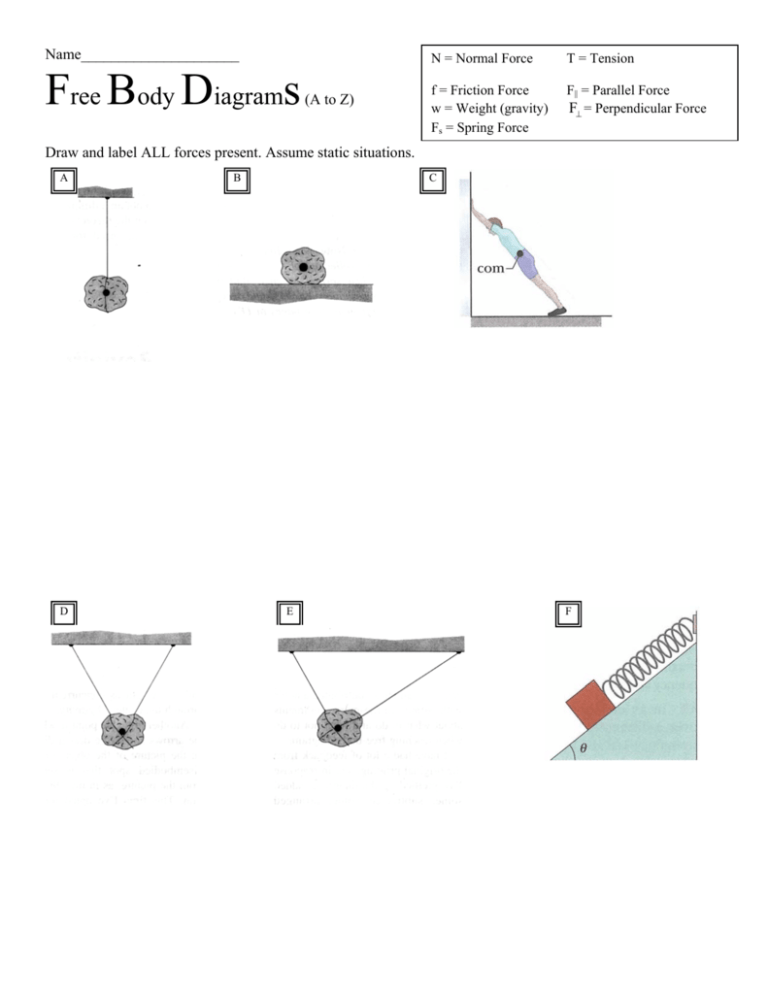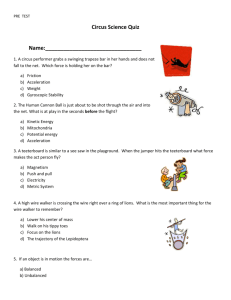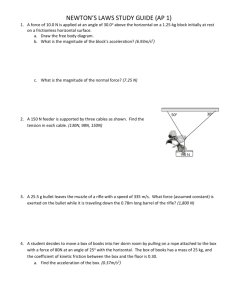Name_____________________ Free Body Diagrams(A to Z) Draw
advertisement

Name_____________________ Free Body Diagrams (A to Z) N = Normal Force T = Tension f = Friction Force w = Weight (gravity) Fs = Spring Force F|| = Parallel Force F = Perpendicular Force Draw and label ALL forces present. Assume static situations. A D B C E F G J H I K L M O N P Q R S forklift U T slides V X W Y Z PRACTICE WORKSHEET Newton’s Laws Conceptual questions: 1. Explain the difference between mass and weight. 2. The acceleration of an object is zero. Explain how there can be forces acting on it. 3. If you walk on a log that is floating in water, why does the log move backwards? 4. If only one force acts on an object can the object have zero acceleration? Zero velocity? 5. Driving down the road you hit the brakes suddenly. As a result your body moves toward the front of the car. Explain, using Newton’s laws. 6. A whole brick has twice the weight of half a brick. Why doesn’t the whole brick fall faster? 7. Determine which of Newton’s three laws applies to the following situation (use 1,2, or3) ______ A wet ball is harder to kick than a dry one. ______ Push the wall and the wall pushes you back. ______ A hockey puck slides to a stop on the ice. ______ A cement truck is harder to stop than a mini cooper. ______ A table cloth can be pulled from under a glass of water. ______ More mass means less acceleration. ______ A rocket pushes gases backwards and the rocket travels forward. NET FORCE ( F) FOR ALL PROBLEMS: SOLVE FOR THE UNKNOWNS: FIND THE NET FORCE AND THE ACCELERATION: Solve for the unknowns: m = 90 kg m = 925 kg 30 N FNET = ________ a = +0.85 m/s2 15 N Fcrane = _________ 550 kN a = _______ 50 N 20 N 6500 N 8500 N 365,000 N 2 a = 0.095 m/s FNET = __________ m = ____________ 150 N 30 kg 10 N m = 80 kg a = 3 m/s2 F1 2N 8N m = 3.0 kg Ff = _____________ FNET = ________ F1 = ____________ a = _______ FNET = ________ a = _______ 1. What force is required to accelerate a 26.0 kg block at 4.50 m/s2? 2. What is the acceleration of a 95.0 kg hockey player "shaving ice" while stopping if the force applied is -150. N? [117 N] [-1.58 m/s2] 3. When firing, a gun accelerates a 0.0149 kg bullet from rest to 259.1 m/s in 0.178 m. What force is applied to the bullet? [2810 N] 4. A person claims to be able to “stop on a dime”. What force is required to stop the person if their mass is 84.0 kg and they are running at 4.47 m/s? The distance they travel is the diameter of a dime, 1.8 cm. [46,600 N] 5. A 1700.0 kg car is traveling at a constant speed of 28.0 m/s. The force required to keep it at this constant speed is 850.0 N. What is the size of the air drag force (FD)? What happens to the car if the driver increases the car’s force to 1000.0 N? [850.0 N] [car accelerates at 0.0882 m/s2] 6. What is the mass of the box if it accelerates (no friction) at 0.75 m/s2? [4.0 kg] 7. What will be the acceleration of the 25 kg box below (no friction)? [+0.08 m/s2] 8. What will be the acceleration of the following (frictionless)? With what force does block A push block B? F =70 N 5 kg 12 kg [4.1 m/s2, 49 N] 9. What is the weight (w) of Mr. McGeechan (mass = 83.9 kg)? [822 N] 10. What is the weight of a 25 kg anvil? [245 N] 11. A bowling ball has a weight of 71 N. What is the bowling ball’s mass in kg? In lbs? [7.24 kg, 16 lbs.] 12. A 65 kg barrel is being pulled upward by a rope whose tension is 700 N. a. What is the weight of the barrel? b. What is the net force on the barrel? c. What will be the acceleration of the barrel a. [637 N b. [63 N]] c. [+0.97 m/s2] Friction Problems: 13. A 7.50 kg book is sitting on a table that has a K = 0.85 and a S = 1.30. A. What is the normal force exerted on the book by the table? [73.5 N] B. What force is required to get the book to move? [95.6 N] C. A force of 110. N is applied to the book, how long will it take to travel 15.0 m? [2.18 s] 14. An 18 kg block is pulled to the right by a force of 115 N but it does not move! A. What is the normal force on the block? [176 N] B. What is the size of the friction force on the block? [115 N] C. What is the coefficient of friction ( )? [0.65] N 115 N 15. A 35 kg crate is pushed along the floor by a force of 250. N A. What is the force of gravity on the crate (weight)? B. What is the normal force on the crate? C. If the ground is frictionless….what will be the acceleration of the crate? D. If the box accelerates at 2.24 m/s2, what is the frictional force on the crate? E. For part D, what is the coefficient of friction ( )? A. [-343 N] B. [+343 N] C. [7.14 m/s2] D. [171.6 N] E. [0.500] 16. An 80.0 kg firefighter slides down a pole with an acceleration of 4.0 m/s2. What is the friction force that acts on the firefighter? [464 N] 17. An object takes 12.3 meters to stop because of friction. If the coefficient of friction is 0.82, what is the initial velocity of the object? [14.1 m/s] 18. 3 forces here…A 15.0 kg box is being pulled to the right by a tension of 75 N and is pulled to the left by a force of 20.0 N. In addition, there is friction that has a =0.20. DRAW A DIAGRAM! A. What is the net force on the box? B. What will be the acceleration of the box? C. How fast will the box be moving after 5.0 seconds? (starts from rest) A. [+25.6 N] B. [1.71 m/s2] C. [8.55 m/s] 19. A physics book is sent sliding across on a table that has a K = 0.55 with a velocity of 3.5 m/s A. What is the acceleration of the book? [-5.39 m/s2] B. How long will it take to stop? [0.65 s] 20. A chair is sliding across the room at a speed of 3.0 m/s. It comes to rest in 1.25 seconds. What is the coefficient of kinetic friction between the floor and the chair? [0.244] 21. A 5.0 kg box is held at rest against a vertical wall by a horizontal force of 100.0 N. A. What is the frictional force exerted by the wall on the block? B. What must the S of the wall? C. What is the minimum horizontal force needed to prevent the block from falling if S = 0.40? 100 N A. [49 N] B.[0.49] C.[123 N] 22. In 2007 a fatal accident occurred in Florida. It was caused when a truck traveling at 31 m/s could not see the cars stopped in front until it was 80.0 m away. Assuming K for the tires is 0.55, what is the shortest possible stopping distance for the truck? [89 m] 23. A 0.0900 kg beach ball is thrown upward with an initial velocity of 14 m/s in air its maximum height is 7.8 m. What is the average air drag on the ball during its upward motion? [-2.02 N] Elevators and Pulleys 24. A 75.0 kg person is standing on scale in an elevator. What is the elevator doing if: A. The scale reads 735 N. B. The scale reads 1838 N C. The scale reads 700.0 N [constant v or at rest] [a = +14.7 m/s2] [a = -0.47 m/s2] 25. The 52 kg crate is held at rest. What is the tension in the chain connected to the crate? In the rope? [510 N, 255 N] 26. The 55 kg woman is standing on scale in an elevator that is accelerating upward at 2.2 m/s2. What will the scale read? [660 N] 27. Determine the tension all ropes of the following: 60 kg [588 N, 294 N, 147 N, 73.5 N] 28. The 25 kg Stewie is standing on scale in an elevator. What will the scale read if: A. The elevator is at rest or moving with a constant speed B. The elevator is accelerating up at 3.5 m/s2 C. The elevator is accelerating down at -7.0 m/s2 [245 N] [333 N] [70 N] 29. The boy lowers the 250 kg safe by exerting a force of 1163 N on the rope at point B. How long will it take for the safe to reach the ground? (starts from rest) 4.0 m [4.0 s] 30. Determine the tension in all of the ropes of the following: 8 kg [78.4 N, 39.2 N, 19.6 N, 39.2 N] Multi-Body Problems: Draw FBD and solve for unknowns. All pulleys are massless. 31. a and T 13 kg T 8 kg [a = 2.3 m/s2, T = 97 N] 32. a and T T 6 kg 2 kg [a = 2.5 m/s2, T = 15 N] 33. a and T = 0.25 4 kg T 5 kg [a = 4.4 m/s2, T = 27 N] 34. µ = ? a = 1.5 m/s2 7 kg 3 kg [ = 0.21] 35. m = ? a = 4.0 m/s2 6 kg m [m = 4.1 kg] 36. m = ? = 0.15 m 3 kg a = 2.0 m/s2 [m = 6.7 kg] 37. a, T1, T2 T1 20 kg 5 kg T2 10 kg [a = 1.4 m/s2, T1 = 168 N, T2= 112 N] 38. a, T1, T2 4 kg T1 6 kg T2 2 kg [a = 3.3 m/s2, T1 = 39 N, T2= 26 N] 39. a, T1, T2 = 0.2 3kg T2 T1 7 kg 2 kg [a = 3.6 m/s2, T1 = 43 N, T2= 27 N] 40. What must S be in order for the system to be at rest? 8.0 kg 15 kg [1.88] 41. If S = 1.22 and K = 0.95, what will be the acceleration of the system? 8.0 kg 15 kg [3.15 m/s2] 42. What is the acceleration of the system and the tension in the string given µK = 0.89? 8.0 kg 15 kg [a = 3.36 m/s2] [T = 96.6 N] 43. What would the µS have to be in order for the system in #42 to remain at rest (not move) [1.88] 44. If K = 0.35, what will be the acceleration of the system? 4.0 kg 2.0 kg 5.0 kg [1.43 m/s2] 2 45. The acceleration of the system is 5.00 m/s what must the coefficient of kinetic friction? 6.0 kg 13 kg [0.55] 46. What will be the tension in the cord in #45? [62.4 N] 47. Determine the acceleration and tension in the string if P = 140 N. mA = 8 kg, mB = 5 kg = 0.25 = 0.15 [a = 7.4 m/s2, T = 49.3 N] 48. For all surfaces K = 0.3. mA = 5 kg and mB = 4 kg. Determine the acceleration of A and the tension in the cord. 80 N [aA = 8.4 m/s2, T = 11.8 N] STATICS 49. Calculate the tension in the ropes in the following situations: A. 15 15 T2 T3 T1 25.0 kg T1 = 245 N T2 = T3= 473 N B. 27 13 T1 T2 75.0 kg T1 = 1114 N T2 = 1019 N C. T2 T3 T1 m = 250. kg T1 = 2450 N T2 = 4900. N T3 = 4244 N D. 33 T2 T1 60 T3 m = 15. kg T1 = 147 N T2 = 2432 N T3 = 2356 N 50. Determine T and F. 28 T F m=15.0 kg T = 166.5 N F = 78.2 N 51. Determine the mass. 38 38 120. N m m = 15.1 kg 52. What is the maximum value of m so that the system is at rest if S = 0.25? 16 kg m m = 4.0 kg 53. Determine the tensions TBA and TCA in the ropes located below (hint get angles 1st): 0.70 m TBA = 533 N TCA = 394 N 54. Determine T1 , T2 , and T3. What must be the of the table top? T2 25 8 kg T3 T1 3 kg T1: 29.4 N T2: 69.6 N T3: 63 N : 0.80 N 55. Determine the angle in the following situation: T =160 N 9 kg = 16° 56. Find the unknown tensions and mass of the following: (a) T1: 60 N T2: 52 N m: 5.3 kg 50° (b) T1: 52.2 N T2: 35.7 N m: 3.6 kg (c) T1: 33.9 N T2: 58.8 N T3: 33.9 m: 3.5 kg 57. If the engine has a mass of 175 kg. Determine T1 and T2. T1: 1800 N T2: 317 N







